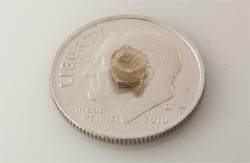Wireless Sensor Transmits Tumor Pressure

Babak Ziaie, PhD, Purdue University Wireless interstitial fluid pressure sensor shown to scale on a dime.
The interstitial pressure inside a tumor is often remarkably high compared to normal tissues and is thought to impede the delivery of chemotherapeutic agents as well as decrease the effectiveness of radiation therapy. While medications exist that temporarily decrease tumor pressure, identifying the optimal window to initiate treatment—when tumor pressure is lowest—remains a challenge. With support from NIBIB, researchers at Purdue University have developed a novel sensor that can wirelessly relay pressure readings from inside a tumor.
Contents under Pressure
Tumors, like healthy tissues, need oxygen and nutrients to survive. In order to accommodate the demands of a growing tumor, blood vessels from surrounding tissue begin to grow into the tumor. Yet, unlike normal tissue, these newly formed blood vessels are disorganized, twisty, and leaky. It’s thought that the high pressure observed in tumors is a result of these abnormal blood vessels, which leak fluid and proteins into the area between tumor cells, known as the interstitial space.
In normal tissues, tightly regulated differences in pressure pull nutrients out of a tissue’s blood vessels and into the interstitial space, where they can be taken up by cells. Medications travelling through the blood also rely on these pressure differences in order to reach cells. When pressure in the interstitial space increases—as is the case in many tumors—medications are less apt to leave blood vessels. As a result, patients who have tumors with high interstitial pressure often receive a less than adequate dose of chemotherapy or other types of anti-cancer drugs. In addition, high interstitial pressure can also contribute to low oxygen levels in tumors. Because radiation therapy requires the presence of oxygen to be effective, tumors with high interstitial pressure are often less receptive to radiation therapy.
Window of Opportunity
Results from recent clinical trials and studies in animals suggest that a class of anti-cancer drugs called angiogenesis inhibitors may be able to temporarily reduce interstitial pressure and improve the efficacy of chemotherapy and radiation treatments. Angiogenesis inhibitors prevent the growth of new blood vessels and have long been investigated as a way to stop tumor growth. Recently, it has been hypothesized that there is a brief window after these drugs are given in which blood flow to tumors is actually normalized. This window provides an opportunity to more efficiently deliver chemotherapeutic drugs and radiation therapy.
However, because efficient methods for measuring interstitial tumor pressure are lacking, determining the optimal time to begin chemotherapy or radiation treatment within this normalization window remains a challenge.
“Right now, the only option for measuring pressure is to stick a needle inside the tumor. That’s not practical for clinical applications,” says Babak Ziaie, Ph.D, director of the Biomedical Microdevices Laboratory at Purdue University.
A Wireless Pressure Sensor
After conversations with radiation oncologists with whom he collaborates, Ziaie decided to take on the challenge of creating a tumor pressure sensor. He was enticed by the novelty of the project. “No one had done this before,” said Ziaie. “No one was working on it or even attempting it.”
With support from NIBIB, Ziaie and his research team created a novel sensor that can be implanted into a tumor to wirelessly transmit interstitial fluid pressure readings. The sensor is an adaptation of a technology developed in the 1950s called the Guyton capsule, which is a perforated capsule that, once implanted, allows interstitial fluid to flow through it. Subsequent insertion of a needle into the capsule provides direct access to the interstitial fluid for pressure measurements.
Using special microfabrication techniques, Ziaie created a miniaturized wireless pressure sensor and combined it with a Guyton-like capsule so that it could generate interstitial pressure readings without the use of a needle and that could be read remotely.
Recently, Ziaie and his team tested the device by implanting it into pancreatic tumors in mice and were able to show a decrease in interstitial tumor pressure following administration of an angiogenic inhibitor.
“This is a great example of the power of convergence science,” said Tiffani Lash, PhD, program director for sensor technologies at NIBIB. “Integrating knowledge from the life and physical sciences with engineering concepts can help solve important clinical problems. It’s about thinking creatively to generate novel ways to treat disease.”
Margot Kern
Writer/Editor
nibibpress@mail.nih.gov
Phone: 301-496-3500
Media Contact
All latest news from the category: Medical Engineering
The development of medical equipment, products and technical procedures is characterized by high research and development costs in a variety of fields related to the study of human medicine.
innovations-report provides informative and stimulating reports and articles on topics ranging from imaging processes, cell and tissue techniques, optical techniques, implants, orthopedic aids, clinical and medical office equipment, dialysis systems and x-ray/radiation monitoring devices to endoscopy, ultrasound, surgical techniques, and dental materials.
Newest articles

High-energy-density aqueous battery based on halogen multi-electron transfer
Traditional non-aqueous lithium-ion batteries have a high energy density, but their safety is compromised due to the flammable organic electrolytes they utilize. Aqueous batteries use water as the solvent for…

First-ever combined heart pump and pig kidney transplant
…gives new hope to patient with terminal illness. Surgeons at NYU Langone Health performed the first-ever combined mechanical heart pump and gene-edited pig kidney transplant surgery in a 54-year-old woman…

Biophysics: Testing how well biomarkers work
LMU researchers have developed a method to determine how reliably target proteins can be labeled using super-resolution fluorescence microscopy. Modern microscopy techniques make it possible to examine the inner workings…





















